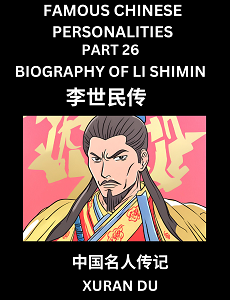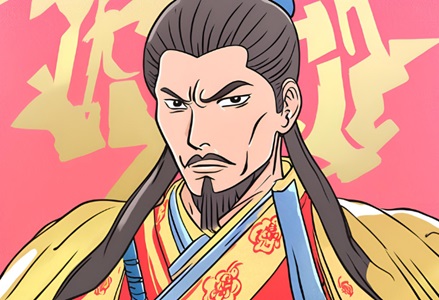Title of Biography in Chinese, Pinyin: 李世民传 (Lǐ Shìmín Zhuàn).

Title of Biography in English: The Biography of Li Shimin.
Check out books on my Amazon and Barnes & Noble homepages as well as the following pages to learn Biographies of famous Chinese personalities-
- Part 1 – Chinese Biography Book Series for Beginners
- Part 2 – Chinese Biography Book Series for Beginners
- Part 3 – Chinese Biography Book Series for Beginners

The Biography of Li Shimin in English (英文)
Li Shimin: The Glorious Emperor of the Tang Dynasty

Li Shimin, the second emperor of the Tang Dynasty, was one of its most illustrious monarchs. Born in 599 AD, he was intelligent from a young age and deeply favored by his father, Li Yuan. In the early days of the Tang Dynasty, Li Shimin actively participated in military campaigns, displaying his remarkable military talent.
In 626 AD, Li Shimin successfully seized the throne through the Xuanwumen Rebellion. Upon ascending to the throne, he dedicated himself to reforming the political system, strengthening centralization, and promoting economic prosperity and cultural development. He implemented the Equal Field System, enabling farmers to obtain more land and thus increasing agricultural production. He also encouraged commercial trade, promoting urban economic prosperity. In the field of culture, he advocated Confucianism and attached great importance to education, leading to the peak of Tang culture.
During his reign, the territory of the Tang Dynasty expanded significantly, and its national strength grew stronger. He successively pacified separatist forces such as Wang Shichong and Dou Jiande, unifying the country. At the same time, he dispatched troops to the west, successfully conquering the Western Regions and establishing the Anxi Protectorate, extending the Tang Dynasty’s influence to Central Asia.

Li Shimin reigned for 23 years, initiating the “Reign of Zhenguan,” laying a solid foundation for the prosperity and strength of the Tang Dynasty. After his death, he was revered as “Emperor Taizong,” and his tomb, located in Jiuzhong Mountain, Liquan County, Shaanxi Province, is one of the representative imperial tombs in ancient China.
Learn Biography Of Li Shimin in Chinese (中文传记)
李世民,唐朝的第二位皇帝,也是唐朝最杰出的君主之一。他出生于公元599年,自幼聪明过人,深受父亲李渊的喜爱。在唐朝建立初期,李世民便积极参与了多次军事行动,展现出了非凡的军事才能。

公元626年,李世民通过玄武门之变成功夺位,成为唐朝的新皇帝。他即位后,致力于改革政治体制,加强中央集权,推动经济繁荣和文化发展。他实行了均田制,使得农民得到了更多的土地,从而提高了农业生产;他还鼓励商业贸易,促进了城市经济的繁荣。在文化方面,他倡导儒学,重视教育,使得唐朝的文化达到了鼎盛时期。
李世民在位期间,唐朝的疆域得到了极大的扩张,国力日益强盛。他先后平定了王世充、窦建德等割据势力,统一了全国。同时,他还派遣军队西征,成功征服了西域,设立了安西都护府,将唐朝的势力扩展到了中亚地区。
李世民在位二十三年,开创了唐朝的“贞观之治”,为唐朝的繁荣和强盛奠定了坚实的基础。他逝世后,被尊为“太宗皇帝”,其陵墓位于陕西省礼泉县九嵕山,是中国古代帝王陵墓的代表之一。
Li Shimin Biography Keywords- English, Chinese & Pinyin (关键词)

- 李世民(Lǐ Shìmín):Li Shimin: The second emperor of the Tang Dynasty and one of its most outstanding monarchs.
- 玄武门之变(Xuánwǔmén Zhībiàn):Xuanwumen Rebellion: The event that led to Li Shimin’s ascension to the throne.
- 均田制(Jūntián Zhì):Equal Field System: A land reform policy implemented by Li Shimin to distribute land to farmers.
- 贞观之治(Zhēnguān Zhīzhì):The Reign of Zhenguan: A period of political stability, economic prosperity, and cultural florescence during Li Shimin’s reign.
Pinyin of Li Shimin Biography (李世民传记的拼音)

Lǐshìmín, táng cháo de dì èr wèi huángdì, yěshì táng cháo zuì jiéchū de jūnzhǔ zhī yī. Tā chūshēng yú gōngyuán 599 nián, zì yòu cōngmíngguò rén, shēn shòu fùqīn lǐyuān de xǐ’ài. Zài táng cháo jiànlì chūqí, lǐshìmín biàn jījí cānyùle duō cì jūnshì xíngdòng, zhǎnxiàn chūle fēifán de jūnshì cáinéng.
Gōngyuán 626 nián, lǐshìmín tōngguò xuánwǔ mén zhī biàn chénggōng duó wèi, chéngwéi táng cháo de xīn huángdì. Tā jíwèi hòu, zhìlì yú gǎigé zhèngzhì tǐzhì, jiāqiáng zhōngyāng jíquán, tuīdòng jīngjì fánróng hé wénhuà fāzhǎn. Tā shíxíngle jūn tiánzhì, shǐdé nóngmín dédàole gèng duō de tǔdì, cóng’ér tígāole nóngyè shēngchǎn; tā hái gǔlì shāngyè màoyì, cùjìnle chéngshì jīngjì de fánróng. Zài wénhuà fāngmiàn, tā chàngdǎo rúxué, zhòngshì jiàoyù, shǐdé táng cháo de wénhuà dádàole dǐngshèng shíqí.
Lǐshìmín zài wèi qíjiān, táng cháo de jiāngyù dédàole jí dà de kuòzhāng, guólì rìyì qiángshèng. Tā xiānhòu píngdìngle wángshìchōng, dòujiàndé děng gējù shìlì, tǒngyīliǎo quánguó. Tóngshí, tā hái pàiqiǎn jūnduì xī zhēng, chénggōng zhēngfúle xīyù, shèlìle ānxī dū hù fǔ, jiāng táng cháo de shìlì kuòzhǎn dàole zhōng yà dìqū.
Lǐshìmín zài wèi èrshísān nián, kāichuàngle táng cháo de “zhēnguàn zhī zhì”, wèi táng cháo de fánróng hé qiángshèng diàndìngle jiānshí de jīchǔ. Tā shìshì hòu, bèi zūn wèi “tàizōng huángdì”, qí língmù wèiyú shǎnxī shěng lǐ quán xiàn jiǔ zōng shān, shì zhōngguó gǔdài dìwáng língmù de dàibiǎo zhī yī.


